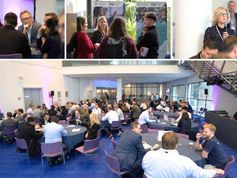Greenshoring: UK manufacturing’s future?
Sam Turner, Net Zero Champion for the High Value Manufacturing Catapult (HVMC). Explained to the Sustainable Industry community, that the UK can become the green shoring location of choice for manufacturing supply chains. Doing so relies on creating common standards for carbon emissions reporting.
Industrial production accounts for about 20% of the world’s total carbon emissions. In the UK, that figure is closer to 40%. The growing urgency of shifting to a low carbon economy means more and more companies are seeking to develop greener supply chains.

For decades, the standard business practice has been to manufacture goods in less-developed countries as cheaply as possible. This offshoring of production has helped greatly in making goods more affordable and accessible to the mass market. But it also carries a far greater environmental impact due to less efficient factory processes and long-distance transport.
Now, an emerging trend is challenging the dominance of offshoring. Green shoring takes the focus from low cost and places it on low carbon. As more and more companies make commitments to achieve net zero, green shoring will become a key part of the manufacturing sector’s sustainable transformation.
As a result, regions that can evidence a low carbon manufacturing supply base will have a key competitive advantage in the race to net zero.
The benefits of establishing such a low carbon supply base are four-fold:
It will contribute greatly towards the UK meeting its net zero targets
It will preserve and strengthen the global competitiveness of UK manufacturing
It will grow the contribution from manufacturing to the UK economy
It will safeguard and generate jobs and stimulate business investment
The UK has a strong opportunity, though not uniquely so, to gain a first-mover advantage around green shoring and low carbon manufacturing. Successfully exploiting this advantage, however, relies on addressing the lack of common carbon auditing and monitoring standards.
Carbon accounting is becoming increasingly important for all companies that wish to understand and track the carbon emissions associated with their products or services.
Without a proper auditing and monitoring system in place, there is no way of knowing where the manufacturing sector is in terms of progress toward organisational and national net zero targets.
A universal methodology for measuring and reporting emissions must be developed, with government agreement on which metrics must be used, says Sam Turner, Net Zero Champion at the High Value Manufacturing Catapult (HVMC).
What is the size of the Green Shoring opportunity to UK manufacturing and the wider economy, and over what timescale?
Green shoring isn’t reshoring, it isn’t bringing back that which was once made in the UK. This is about being globally competitive based on having a demonstrably low carbon, sustainable manufacturing footprint, alongside other competitiveness measures such as high levels of productivity, innovation and growth.
The opportunity centres on growing the manufacturing sector’s contribution to the UK economy from 10% currently to the 20% of other well-established industrialised nations or greater.
The timescale depends on how quickly the world tips towards carbon being priced in. A key underpinning of the green shoring agenda is that low carbon manufacturing can be evidenced and is valued. When sustainably moves from being voluntary to sitting alongside quality, delivery and cost in terms of influencing decision-making and continuous improvement.
We expect that to happen within the next 10 to 20 years but what’s vital is not simply waiting for that to happen. The work must start now so that when markets do begin to look for that low carbon manufacturing supply base, the UK is the place to go.
Can you share an example of a green shoring success story?
Frog Bikes, based in South Wales, is a great example. In 2021, the business reduced its total emissions by just over 10% year-on-year despite a 14% increase in the number of bikes built.

Part of that came from design improvements to reduce the amount of steel and aluminium used in each bike, but its primary decarbonisation focus is on sourcing lower-carbon aluminium and alternatives to plastic. In doing so, Frog Bikes has also started to secure the downstream manufacturing content, the fabrication, which was currently done overseas.
That’s another key part of the green shoring vision. Most carbon emissions are embodied in the raw materials. Greater control over an increasingly low carbon, local material supply base enables companies like Frog Bikes to bring additional parts of the manufacturing value chain closer to home.
Decisions on whether to undertake green shoring or not will be based on carbon emissions data. What carbon accounting standards and methodologies are being used?
The two most common are life-cycle assessments (LCA) and carbon accounting (CA) tools. Both of these typically are based on the greenhouse gas protocol, the global standard framework for measuring and managing greenhouse gas emissions.
The challenge is that the current standard is quite open-ended so the same data can be interpreted in any number of ways. There’s no consistency or transparency and claims around actions and outcomes can be questioned.
This is especially challenging for industrial businesses given the energy-intensive nature of manufacturing. The lack of common data makes tracking overall emissions reductions almost impossible and vital information can be obscured or lost. This risks completely undermining our collective drive to net zero.
The HVMC is working with partners and relevant government departments to jointly develop universal, consistent standards, as well as signpost where companies can find practical guidance and robust assessment methods in the meantime.
Certainly, there are things a company can do now to get a handle on where the carbon hotspots are in its supply chain. I think it’s right that the starting focus should be Scope 1 (direct) and 2 (indirect) emissions. Those are more clearly defined in terms of the standards and are much easier to account for and measure.
Tracking Scope 3 (indirect value chain) emissions is much more complex because of the sheer number of partners and distance involved. The supply chain of a highly engineered product, for example, can encompass thousands of suppliers and span the globe many times over. Complexity, however, should not be an excuse to bury heads in the sand because for most manufacturers Scope 3 represents between 60% and 95% of embodied carbon emissions.
Equally, additional and tailored assistance is also needed to support SMEs, which account for 99.9% of the business population, to demystify carbon accounting and help them begin or progress their decarbonisation journey.
Does the UK have the required skills, and in sufficient numbers, to exploit the green shoring opportunity?
The skills piece is clearly a challenge. One thing we're exploring at the HVMC is foresighting; identifying what our skills requirements are now and in the future. Short term, the focus should be on leadership to help them measure and understand their carbon footprint and see how and where they can start to reduce it.
We’re also looking at what a low carbon competitive manufacturing supply looks like and its components. How might a business improve resource energy efficiency? What is the role of data management in effective carbon accounting? Could intelligently sourcing help identify and separate those suppliers with a high carbon footprint from those with low carbon emissions?
Design is a key focus area. Much of a product's lifetime emissions are determined at the design stage. How can goods be designed for low carbon manufacture, for the circular economy? These are all key attributes needed for businesses to be successful in a low carbon manufacturing world.
Answering these and other questions will build a clear picture of what our future skills requirements and job profiles look like. Medium term, the focus is working with providers, academia and government to ensure the skills provision is available to meet those requirements.
What advice can you give businesses, what should they be doing right now?
Firstly, don’t wait until a customer or legislation demands you reduce your carbon footprint. Be more proactive and recognise that there is likely to be a cost involved but don’t see it as an additional tax or green levy, view it as a short-term investment for long-term growth and success.
This is also why standards and transparency are so important. Currently, there isn’t an obvious market incentive and reward for decarbonising. That will come at some point, so don’t have carbon pricing imposed upon you, be ready to respond and win those early market opportunities.
Seek help. There is a great deal of support out there, which HVMC or others can provide or signpost, to help you measure and reduce your Scope 1 and 2 emissions. Put Scope 3 higher up your business agenda and find the time to understand where you sit and start drawing up an action plan.
If you can show that you're decarbonising ahead of the market and competition, that’s going to be a huge competitive advantage to your business. The opportunity may be medium term but those who win will be those who take early action.
Also, don't lose sight of the other opportunity provided by decarbonisation and net zero. There is huge growth anticipated for each pathway identified in the UK Government’s Industrial Decarbonization Strategy. Nuclear, wind, solar, hydrogen, carbon capture and storage, electrification, low carbon construction, all will only be delivered at scale if the supply chain can similarly scale up.
Delivering a net zero ecosystem for an entire national economy and infrastructure is a huge challenge but equally, it’s a monumental opportunity both domestically and globally. Businesses working in those markets will likely see a sharp increase in demand because there’s not enough capacity, at least in the short term, to deliver what’s required on a global scale.
The UK, with its legally binding commitment to net zero by 2050, will be at the vanguard of this sea change. So, as well as looking at decarbonising your own manufacturing footprint, I would suggest looking at markets that are going to be desperate for supply chain capacity in the near future.
Equally, identify the attributes and skills that make you competitive in your current sector and see how they may be transferable to some of these new growth markets. Aerospace, for example, has much in common with nuclear.






Comentários